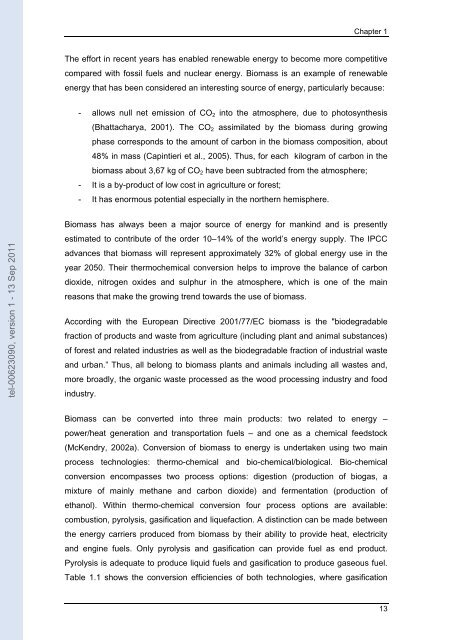Etude de la combustion de gaz de synthèse issus d'un processus de ...
Etude de la combustion de gaz de synthèse issus d'un processus de ...
Etude de la combustion de gaz de synthèse issus d'un processus de ...
You also want an ePaper? Increase the reach of your titles
YUMPU automatically turns print PDFs into web optimized ePapers that Google loves.
Chapter 1<br />
The effort in recent years has enabled renewable energy to become more competitive<br />
compared with fossil fuels and nuclear energy. Biomass is an example of renewable<br />
energy that has been consi<strong>de</strong>red an interesting source of energy, particu<strong>la</strong>rly because:<br />
- allows null net emission of CO 2 into the atmosphere, due to photosynthesis<br />
(Bhattacharya, 2001). The CO 2 assimi<strong>la</strong>ted by the biomass during growing<br />
phase corresponds to the amount of carbon in the biomass composition, about<br />
48% in mass (Capintieri et al., 2005). Thus, for each kilogram of carbon in the<br />
biomass about 3,67 kg of CO 2 have been subtracted from the atmosphere;<br />
- It is a by-product of low cost in agriculture or forest;<br />
- It has enormous potential especially in the northern hemisphere.<br />
tel-00623090, version 1 - 13 Sep 2011<br />
Biomass has always been a major source of energy for mankind and is presently<br />
estimated to contribute of the or<strong>de</strong>r 10–14% of the world’s energy supply. The IPCC<br />
advances that biomass will represent approximately 32% of global energy use in the<br />
year 2050. Their thermochemical conversion helps to improve the ba<strong>la</strong>nce of carbon<br />
dioxi<strong>de</strong>, nitrogen oxi<strong>de</strong>s and sulphur in the atmosphere, which is one of the main<br />
reasons that make the growing trend towards the use of biomass.<br />
According with the European Directive 2001/77/EC biomass is the "bio<strong>de</strong>gradable<br />
fraction of products and waste from agriculture (including p<strong>la</strong>nt and animal substances)<br />
of forest and re<strong>la</strong>ted industries as well as the bio<strong>de</strong>gradable fraction of industrial waste<br />
and urban.” Thus, all belong to biomass p<strong>la</strong>nts and animals including all wastes and,<br />
more broadly, the organic waste processed as the wood processing industry and food<br />
industry.<br />
Biomass can be converted into three main products: two re<strong>la</strong>ted to energy –<br />
power/heat generation and transportation fuels – and one as a chemical feedstock<br />
(McKendry, 2002a). Conversion of biomass to energy is un<strong>de</strong>rtaken using two main<br />
process technologies: thermo-chemical and bio-chemical/biological. Bio-chemical<br />
conversion encompasses two process options: digestion (production of biogas, a<br />
mixture of mainly methane and carbon dioxi<strong>de</strong>) and fermentation (production of<br />
ethanol). Within thermo-chemical conversion four process options are avai<strong>la</strong>ble:<br />
<strong>combustion</strong>, pyrolysis, gasification and liquefaction. A distinction can be ma<strong>de</strong> between<br />
the energy carriers produced from biomass by their ability to provi<strong>de</strong> heat, electricity<br />
and engine fuels. Only pyrolysis and gasification can provi<strong>de</strong> fuel as end product.<br />
Pyrolysis is a<strong>de</strong>quate to produce liquid fuels and gasification to produce gaseous fuel.<br />
Table 1.1 shows the conversion efficiencies of both technologies, where gasification<br />
13

















